- It’s what we do
- KTM Rallye NZ
- Charley Boorman
- Generation Next
- TomTom Rider 550
- Picnic Run
- Braidwood On Royal Enfields
- Trans-Labrador Highway
- BMW F750GS/ F850GS
- Zac Speed: Shaun MacKenzie
- The Arafura Track
- All Class
- West Of The Ridge
- X-com
- Following Dakar
- Wet Road with Andy Strapz
- A Couple Of Firsts with Karen Ramsay
- Checkout
- Fit out
As adventure riding takes over the world, BMW is determined to ensure everyone has the weapons they need to join the conquest.
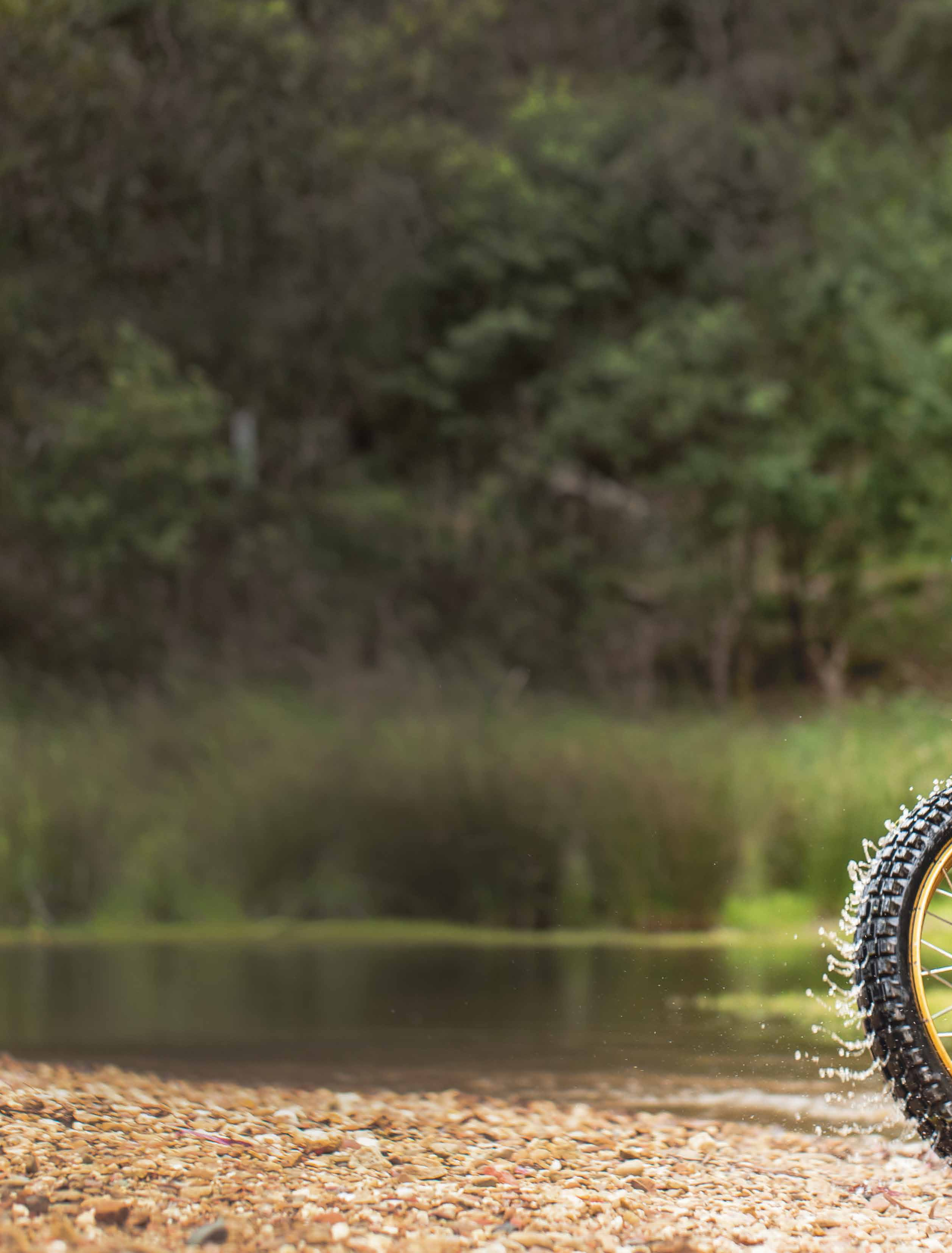
After decades of seeing 1200s as ‘real’ BMWs, and then pretty much a decade of learning the 800GS and GSA was every bit as serious as the 1200, now Beemer has thrown another bolt of lightning into the exploding arena of adventure riding. Now there’s an 850GS. Not only an 850, but a 750GS as well. And that’s only the bell-end of the bratwurst, because within each of those designations is a big array of variations.
As a hint of how far the variations go, the 750GS is actually an 850 as well. Both bikes are running a new, parallel-twin, 853cc motor and come in a big range of option packs. Hold on tight and we’ll run through them for you…
BMW F750GS $13,590
BMW F750GS Tour $17,305
BMW F750GS Low Suspension $13,840
BMW F750GS Tour Low Suspension $17,005
BMW F850GS $17,990
BMW F850GS Rallye $18,390
BMW F850GS Rallye X $22,305
BMW F850GS Tour $21,805
BMW F850GS Low Suspension $18,240
BMW F850GS Rallye Low Suspension $18,640
BMW F850GS Tour Low Suspension $21,505.
It does seem as if our Bavarian chums are determined everyone, no matter what their size or budget, who wants to ride a BMW, can.
Good on BMW, we say. Well done.
A lot to choose from
If it seems like there’s a lot of bikes to choose from to end up on an 850 of one kind or another, we agree. But if you take a moment to have a look, the variations aren’t confusing. The name – like ‘Low Suspension’ – tells most of what a potential buyer needs to know, and the price gives a fair indication of where a particular model variation stands in the line-up.
Along with the new motor, probably the most striking feature of the F750GS and F850GS is how much they can be tuned to an individual. BMW has made a huge effort to offer seats, controls, luggage, footpegs and all kinds of OEM equipment which will allow a buyer to ride the bike away in the trim he or she wants.
We’re not going to try and sort the intricacies of the different variations of the F850GS and F750GS.
You can talk to your local dealer or check the BMW Motorrad website for that. We’re just going to ride ’em and tell you what we reckon. You can work out for yourselves which tweaks and changes will suit you best.
And just to be a little cheeky, we actually had a very short ride on an F850GSA (a special treat, thanks to BMW). It wasn’t available at the time we did this ride, but should be by the time you read this issue. We’ll have a full rundown on that model in issue #34, along with the new 1250GS range.
Meanwhile, hold on tight and turn the page.
It’s a white-knuckle ride.
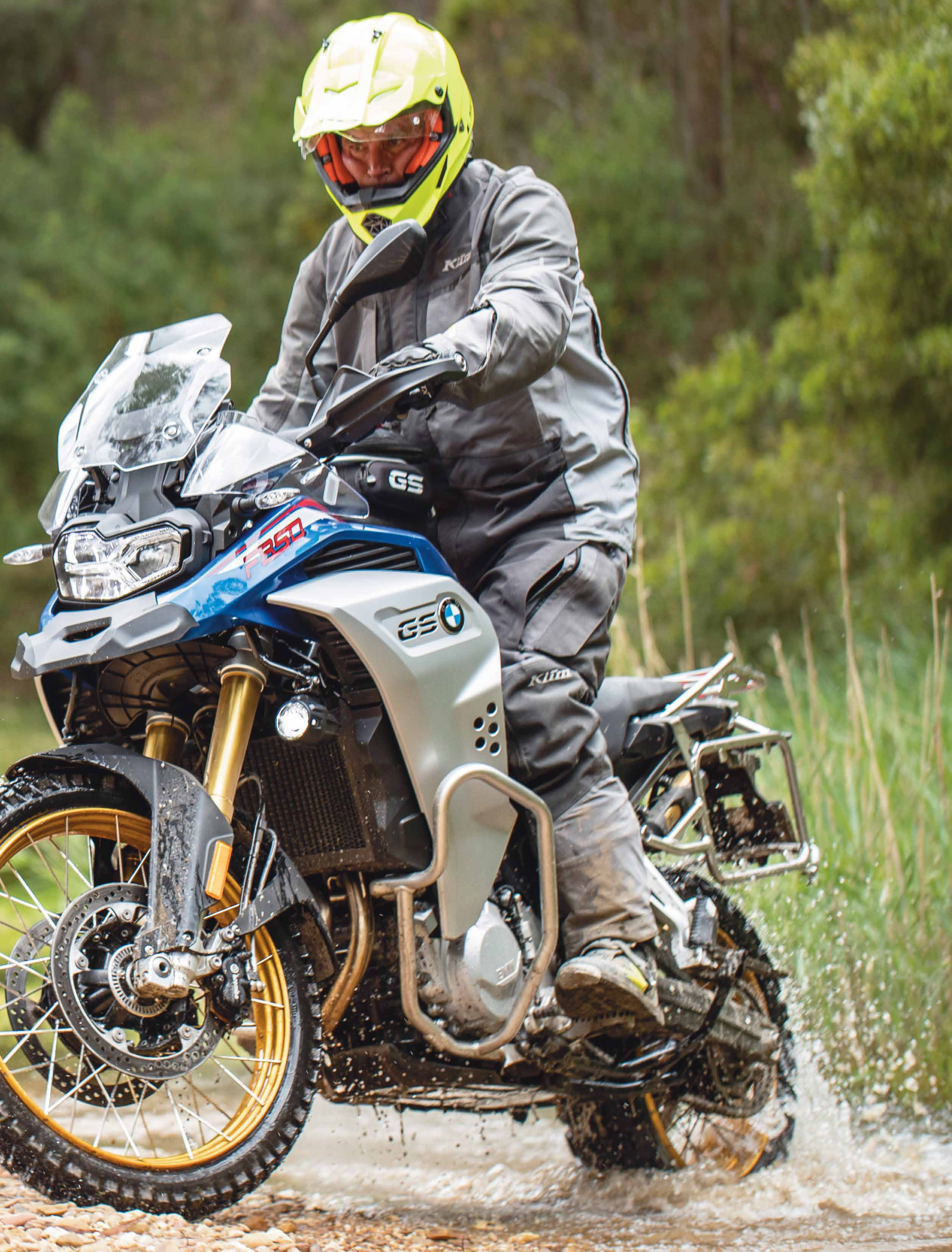 A teaser. We had a very short ride on the F850GS Adventure. We’ll have a full review in issue #34.
A teaser. We had a very short ride on the F850GS Adventure. We’ll have a full review in issue #34.
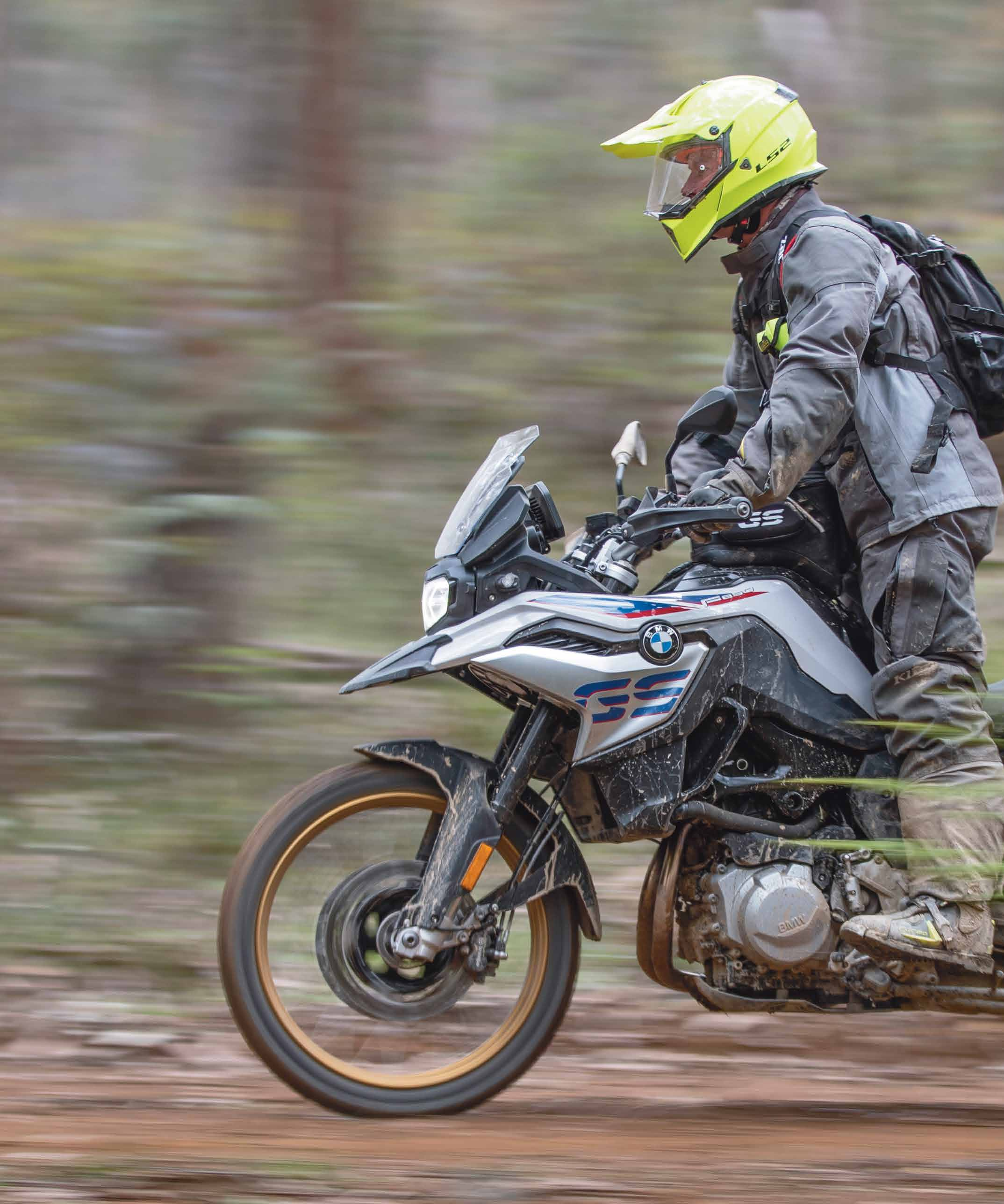 BMW F850GS
BMW F850GS
 BMW claims the F850GS is the most off-road ready bike in its range.We reckon it is, too.
BMW claims the F850GS is the most off-road ready bike in its range.We reckon it is, too.
The F850GS is a BMW through and through.
Those used to the look and feel of Beemers will feel comfortable on this bike the instant they plonk their bum on the seat. The engine may be new, and the bike looks a little aggressive and predatory, but from behind the ’bars the comfort level and shapes and curves are unmistakably BMW.
The 853cc, parallel-twin, liquid-cooled four-stroke motor is most remarkable for its 270-degree firing order.There’s nothing new in that concept, but we’re not used to seeing it from BMW, and the result is a motor with a definite ‘character’ or feel. Power output is claimed to be 95 horsepower and torque 92Nm.
A six-speed box and chain final drive do their job while a cable-operated ‘anti-hopping’ (BMW’s words) clutch and ride-by-wire throttle keep things under control.
All that’s standard across the F850GS range. Things get a little more involved when the electronics packages are taken into consideration.
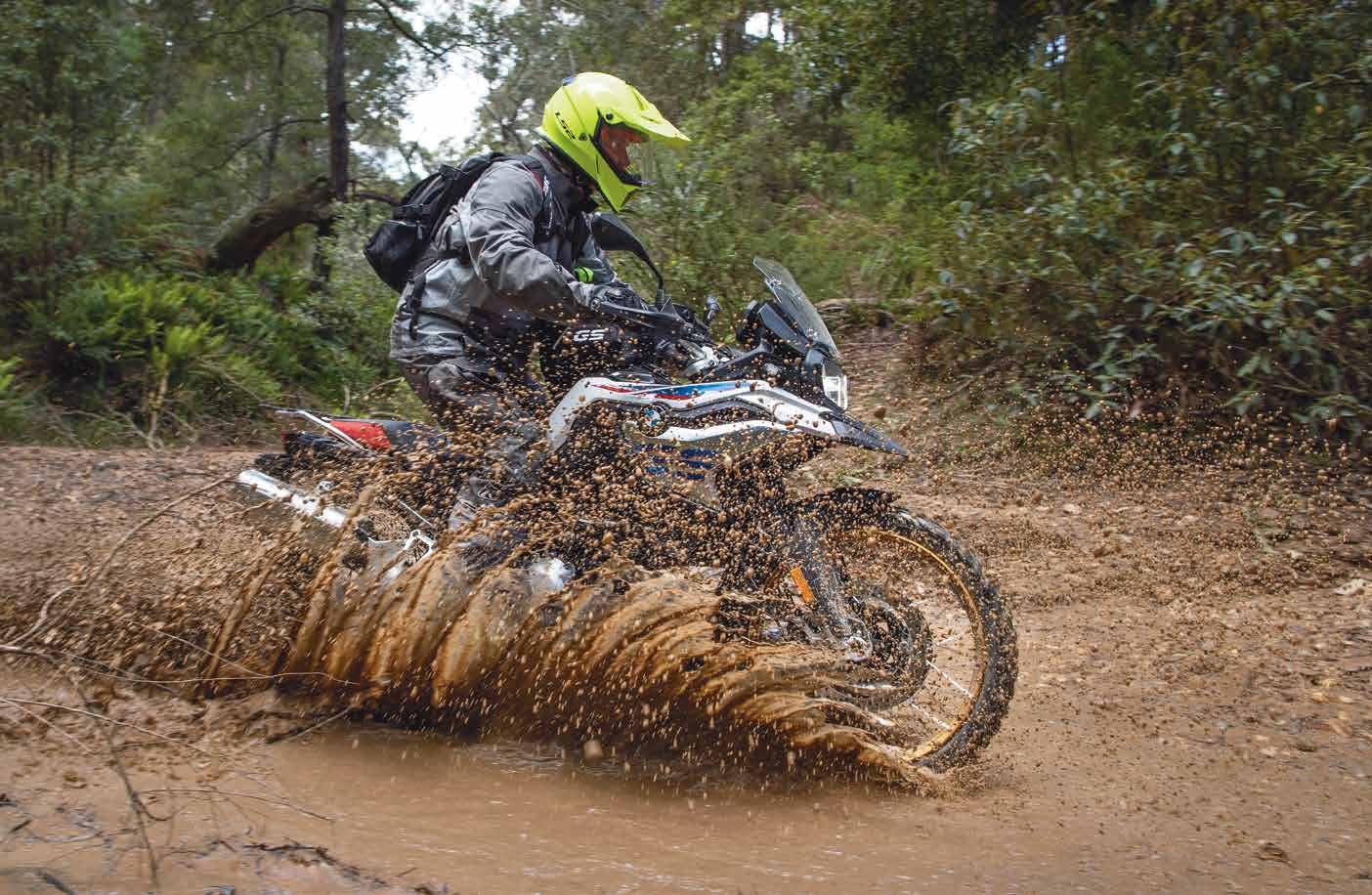 The motor was still incredibly smooth, it’s just kind of…well…playful.
The motor was still incredibly smooth, it’s just kind of…well…playful.
Move on up
Starting with the base model – the GS – there’s a choice of two riding modes: Rain or Road.
Predictably, rain gives a softer throttle response, while road is full snort, and the instrument cluster is an LCD screen. Heated grips, ABS, traction control and cruise control are all standard.
Available options include an HP sports silencer, TFT display with connectivity, anti-theft alarm system, a ‘Comfort’ seat which gives an 875mm seat height, and a ‘Low’ seat gives an 835mm seat height.
From the standard GS a purchaser can look to move up to the various models we listed earlier and will find a lot of the items which are optional for the standard bike are included. One particular fitting which jumped out on the Rallye X was the shift assist. It doesn’t seem like a big deal on a spec sheet, but it makes a surprising difference when the pace is up.
We spent our 850 time on the Rallye X, and we felt it was time very well spent indeed.
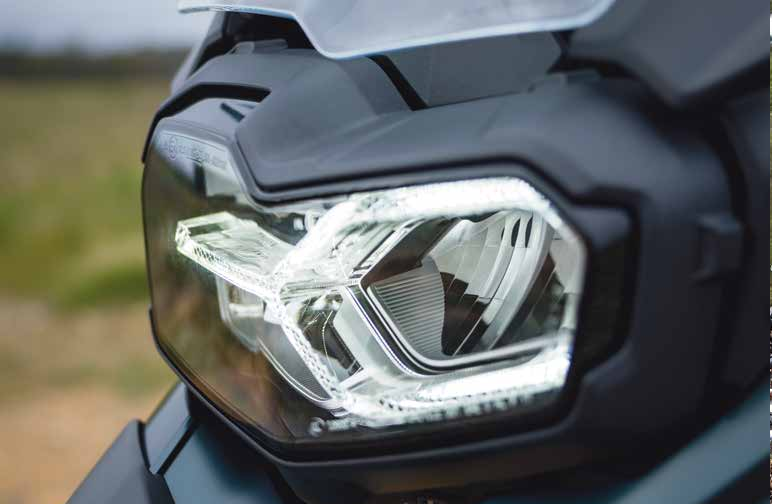 The lighting is really good, and the daytime running light is a cracker…even though the shape’s a bit weird. If it makes motorists look twice, we’re all for it.
The lighting is really good, and the daytime running light is a cracker…even though the shape’s a bit weird. If it makes motorists look twice, we’re all for it.
 The F850GS is a lot of fun off-road.
The F850GS is a lot of fun off-road.
Off-road aggressive
BMW claims the F850GS is the most off-road ready bike in its range, and we can see that’s the case. The bike feels, and even looks, dirt ready. It seems compact and slim, and the instant we climbed on board we were looking for a berm to smash or loamy trail to carve.
The attitude of the bike is that strong.
We didn’t have any problem getting a foot on the ground comfortably, but the bike gave the impression it had plenty of ground clearance. We weren’t squashed sitting on the seat for road sections, either. The ergos of the stock Rallye X felt awesome, straight away.
Being the Rallye X, we also had the TFT screen – which is fricken unbelievable on these bikes – and electronics included Enduro Pro mode, our go-to setting on the BMWs. Changing modes was so easy we found ourselves flicking back and forth to Road mode on the bitumen and Enduro Pro on the dirt, but we could live with the bike being in Enduro Pro all the time.
The bike also had shift assist and all the other standard features we’ve already listed, and as would be expected from BMW, it was all first-class equipment, and we’d used most of it, one way or another, on other models.
The motor is the really new and interesting feature, and we reckon it’s the facet which will get the most attention.
 The TFT screen is fricken unbelievable
The TFT screen is fricken unbelievable
BMW F850GS
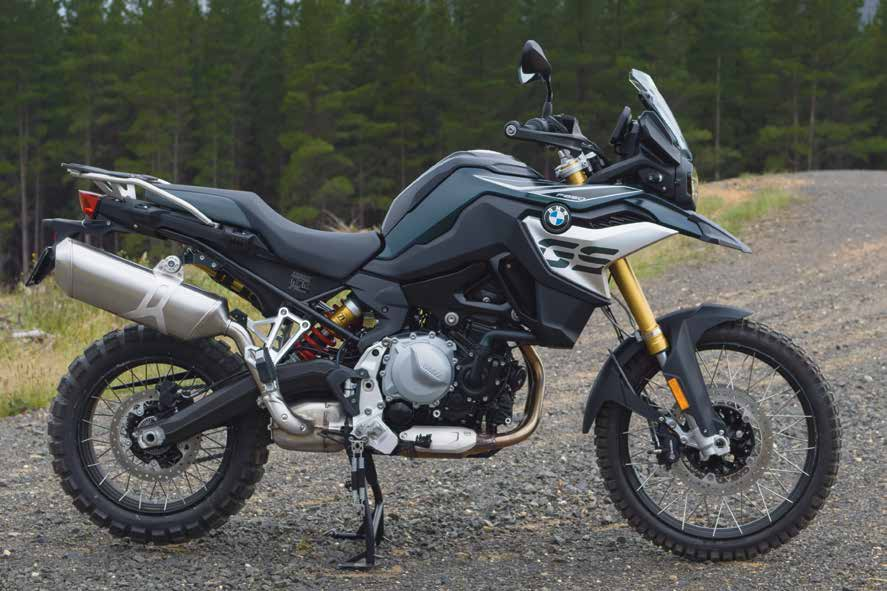
BMW F850GS
Web: www.bmw-motorrad.com.au.
Recommended retail:From $17,990 including GST, plus ORC.
Engine: Water-cooled, two-cylinder, four-stroke with four rocker arm-controlled valves per cylinder, two overhead camshafts and dry sump lubrication
Capacity: 853cc
Bore x Stroke: 84mm x 77mm
Rated output: 70kW (95hp) at 8250rpm
Maximum torque: 92Nm at 6,250rpm
Fuel type: Premium unleaded, 95 octane (RON)
Transmission: Constant-mesh, six-speed
Clutch: Multiple-disc wet clutch (anti hopping), mechanically operated
Start: Electric
Tyres front/rear: 90/90 21, 150/70 R17
Front suspension: Telescopic fork Ø43mm
Rear suspension: Aluminium double-sided swing arm at rear. Central spring strut with WAD (travel-dependent damping). Hydraulically adjustable spring preload, adjustable rebound damping
Brake front: Double disc brakes with floating discs, front (diameter 305 mm), double-piston, floating caliper
Brake rear: Single 265 mm disc, single-piston floating caliper
Wheelbase: 1593mm
Seat Height: 860mm (OE suspension lowering kit: 815mm, OE low seat:
835mm, OE comfort seat: 875mm, OA rallye seat: 890mm)
Usable tank volume: 15 litres
Unladen weight, road ready: 229kg
New and different
We remember when we first rode the 800GS we were amazed at how BMW had somehow made a parallel twin feel very similar to its boxer twin. Over the years we’ve become accustomed to that incredible, seamless, fluid-drive feel as a BMW trait.
But the 850 motor isn’t like that.
Traditionally, a 270-degree firing order makes a parallel-twin motor feel like a V-twin. A pair of staggered power pulses are separated by a comparatively long spell with no ignition. The result is a heartbeat-type feel.
That’s a very different characteristic to the engine drive we’ve been used to from BMW.
We think BMW has given a bit and taken a bit, but will wind up well in front with the new motor. We didn’t make a head-to-head comparison, but we suspect if we did, on an off-road course, the 800GS motor would probably let us turn faster lap times. But for sheer hoot, fun, rortiness – whatever you want to call it – the new motor is a pearler. There’s no shortage of horsepower or drive and it’s really easy to live with. If you’re planning your adventure rides around quick times you’re probably in the wrong sport.
For loping along a forest trail, decimating a squillion kilometres of bitumen and lugging out of a slimy creekbed, the new 850 motor is the dog’s bollocks.
Having said all that, the difference is not as huge as we’re making it seem.
The feel and performance of the motor is undoubtedly and noticeably different to the BMW twins we’ve been used to, but change doesn’t come easily to BMW. It still seemed to us the motor was still incredibly smooth, it’s just kind of… well…playful.
If you weren’t familiar with BMWs we could understand anyone not picking the heartbeat on this one, and whether you do or don’t it’s a great motor.
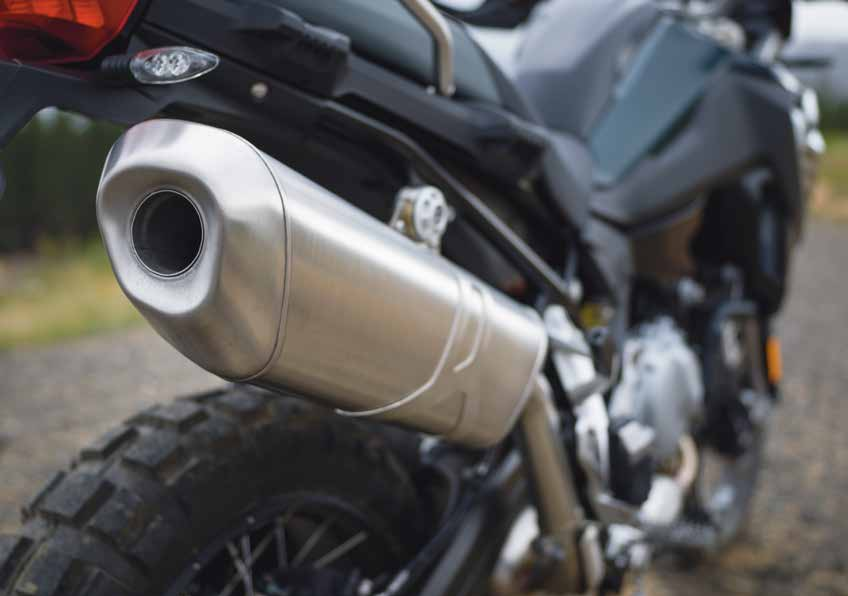 There’s an OEM sport pipe available. Everyone should get one so they can enjoy the burble of the motor.
There’s an OEM sport pipe available. Everyone should get one so they can enjoy the burble of the motor.
Snort fest
The other big feature of the Rallye X variant was the ESA suspension, and it’s really becoming a very polished accessory. It’s so good it’s becoming easy to forget just how much the bike is looking after the rider. Switch it off for a reminder. As it is, it’s a set-and-forget option. Let the bike take care of the suspension settings and the rider take care of the fun. The ESA will do the job better and faster than any rider could make the assessment and adjustment.
Brakes?
C’mon. There aren’t any new bikes with bad brakes these days, and the BMW stoppers are excellent by any standard.
The ABS is as good as the brakes themselves.
Handling?
It’s good. For a bike around 230kg mark, fueled and ready to ride, it still feels quite maneuverable and relatively easy to steer. Even when we had to manhandle it the 850 didn’t seem to fight us. We were very surprised to see the 230kg figure on the spec sheet. It didn’t feel like that at all.
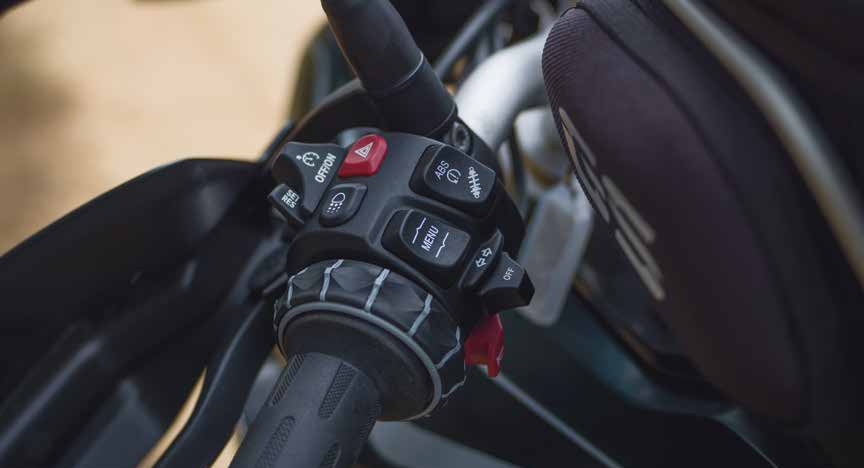 The TFT screen can be controlled from the jog dial on the left-hand ’bar.
The TFT screen can be controlled from the jog dial on the left-hand ’bar.
Ride one
There’s probably not a lot more we can tell you. The 850, in whatever guise you choose, is a very capable off-roader. The BMW GS heritage is clear on the bitumen as well, and long-distance running up and down Australia’s highways would still be a very pleasant experience on this bike.
For those thinking of their first BMW, the 850 would be a superb choice.
The problem for BMW will be convincing current, die-hard 1200GS owners the 850 is a good alternative.
It’s probably not a problem at all. Both choices are good ones.
 BMW F750GS
BMW F750GS
The F750GS is aimed at what might be called ‘old-school’ GS buyers – those who are more interested in the true 50/50 road/off-road lifestyle, rather than the more dirt-oriented focus of the 850GS. The 750GS also offers a more relaxed and less-aggressive option with the new motor. The bike’s a little less teeth-and-claws and a little more coffee-and-cake, if you know what we mean. That makes the new engine available to older riders, less-experienced riders, girls who are a little height-challenged and all those potential owners who just want to sit back and take in the scenery.
Having said that, all those variations and options we outlined earlier on the 850GS are available on this bike too, and when we jumped on the optioned-up Tour model we had to dou-ble-check we weren’t back on the 850.
All the mechanicals are the same on this bike as the 850GS, so refer back a couple of pages for that rundown.
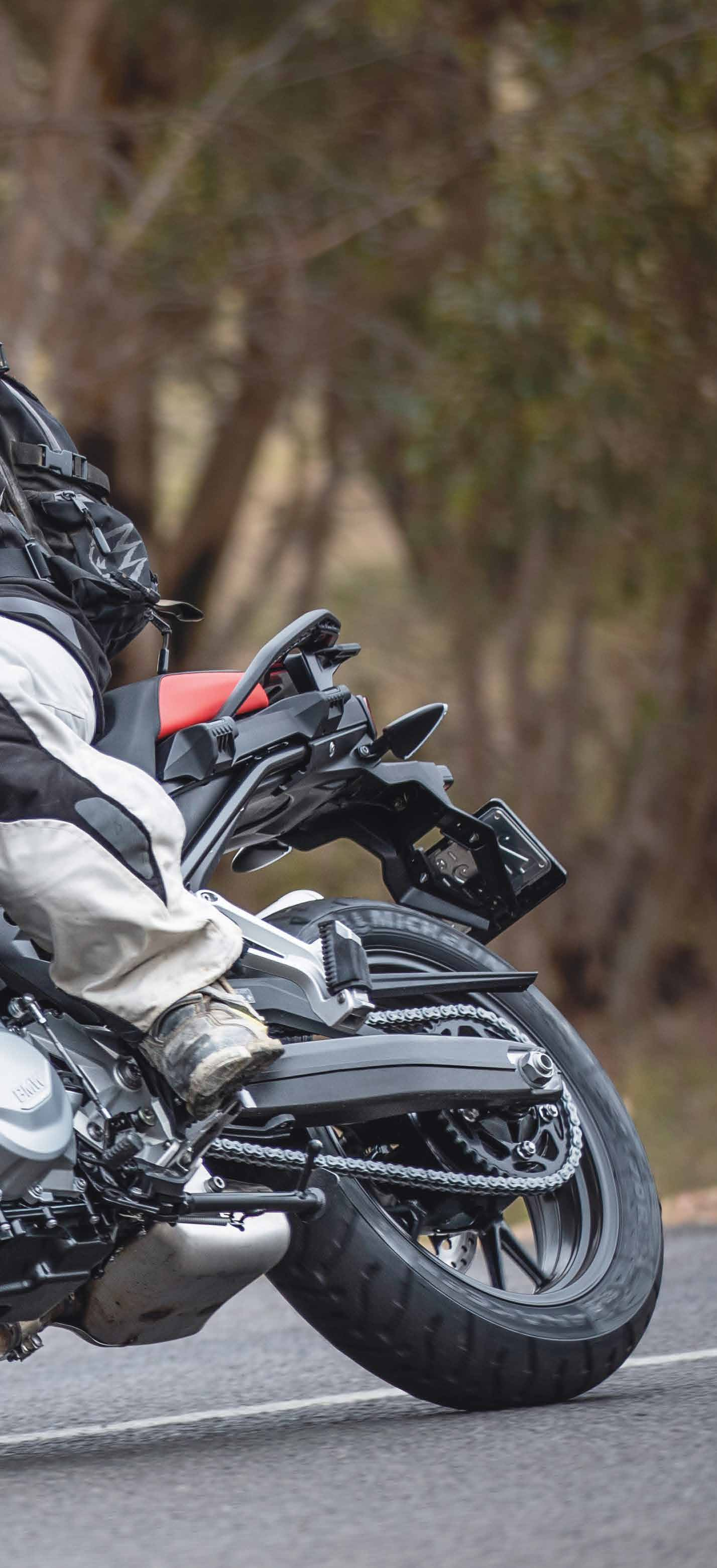 With the standard bike and a few choices from the accessories list, the F750GS could be a dream tourer.
With the standard bike and a few choices from the accessories list, the F750GS could be a dream tourer.
Contrast
What was really interesting for us was where we did all our riding on the 850GS on the Rallye X, we spent a large proportion of our time on the base model 750GS, and it wasn’t an easy transi-tion to make at first.
The F750GS retails at only $13,590 plus on-roads, GST included, and there’s a hell of a lot of class in this bike for that price.
The first thing to hit us was the low seat height, and of course, the LCD screen instead of the TFT screen we’d had on the other bike.
In fact, it didn’t make a lot of difference to our riding experience. The motor, clutch, braking and gearbox were all pretty much the same, and the bike’s desire to grunt away from traffic lights and stop signs was just as pleasant, which was interesting, because according to the spec sheet it’s in a slightly lower state of tune. We missed the Enduro Pro setting like crazy when we hit the dirt, but that was just us being sooks. With the ABS switched off, no ESA and a 19-inch front wheel we found ourselves ‘riding’ the bike a lot more. We had to make the judgements and adjustments in riding style to conquer the ter-rain rather than letting the bike’s electronics and build do it for us. That’s actually something we enjoy a lot.
But there’s no getting around the F750GS being a cost-conscious choice. When we rode the optioned-up 750GS we immediately stacked on some pace and instantly felt like we were ready to conquer the world. The base model made us stop and assess what it would be fair to ask the bike to do, and we kept a pace governed by that assessment.

If you build it
There’s stacks of OEM gear available for the 750GS as well of course. BMW is mak-ing a very big point of just how much these bikes can be sorted to fit individu-als. But still, we were a little nonplussed at some very rudimentary things on the base model.
The journalists were referring to this bike as ‘The Poverty Pack’, by the way, except for one gifted individual who thought it would be better described as ‘the entry point to adventure’ (we’re pre-dicting a big future for that young man). The point of that is to make sure you remember we’re talking about a bike that sells for around $13,500. That’s a helluva deal.
Still, things like not being able to adjust the height of the gear selector were a surprise, and of course, alloy wheels and a key(!). These things really made no dif-ference at all to the pleasure of riding the bike, especially given it’s 50/50 stance.
With the standard bike and a few choic-es from the accessories list, the F750GS could be a dream tourer. It weighs in a little lighter than the 850 as well at 224kg ready to ride, and there’s nothing com-plain about there.
What you want
It’s never easy to review a bike after step-ping back. By that we mean, say, riding a 1200, then stepping back to review a 600. In this case we jumped off a high-spec 850 on to the bog-stock, no frills 750, and we wouldn’t be human if we didn’t feel a little deflated.
But by the end of our time on the bike it’d shown it had the heart of a lion, even if it tended to purr and smooch a little, and we were left with the overall impres-sion of how much we’d enjoyed ourselves. Our minds weren’t racing with all kinds of performance data and hard-edged com-parisons. In fact, we’re a bit embarrassed to admit we were thinking a lot about some of the dirt roads we’d ridden, the scenery we’d enjoyed, and even, truth be told, the pretty waitress at one of coffee shops.
If that’s what you want from a ride, you should have a good long look at the F750GS range. The ideal bike for you is probably in that collection.
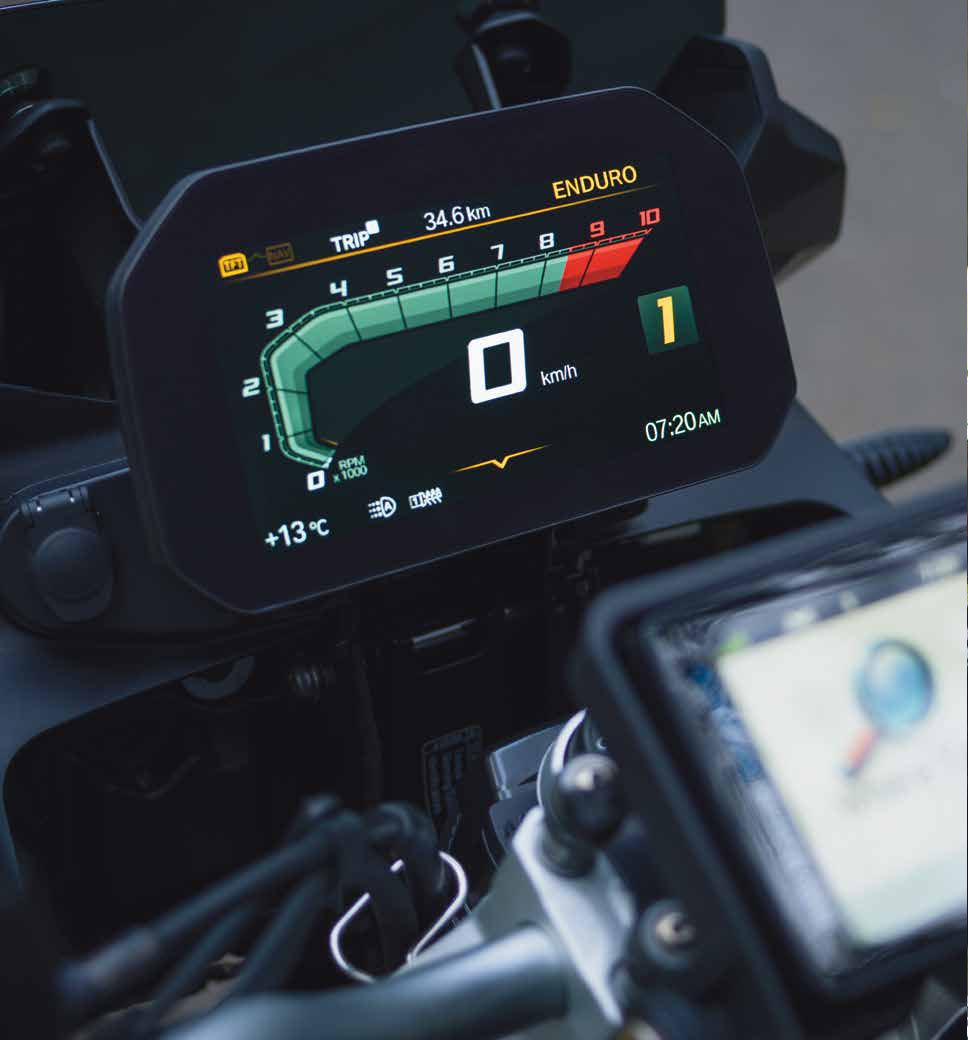 It’s not easy to pick the difference between the F750GS and F850GS sometimes.
It’s not easy to pick the difference between the F750GS and F850GS sometimes.
 The 750GS offers a more relaxed and less-aggressive option with the new motor.
The 750GS offers a more relaxed and less-aggressive option with the new motor.
BMW F750GS

Web: www.bmw-motorrad.com.au.
Recommended retail: From $13,590 including GST, plus ORC.
Engine: Water-cooled, four-stroke, in-line, two-cylinder engine, four valves per cylinder, two overhead camshafts,dry-sump lubrication
Capacity: 853cc
Bore x Stroke: 84mm x 77mm
Rated output: 63kW (77hp) at 7500rpm OE output reduction to 35kW (48hp) at 6500rpm 85hp at 7500rpm
Maximum torque: 83Nm at 6000 rpm OE output reduction: 63Nm at 4500rpm
Fuel type: Unleaded regular, minimum octane number 91 (RON)
Transmission: Six-speed
Clutch: Multiple-disc wet clutch (anti-hopping), mechanically operated
Suspension travel front/rear: 151mm/177mm (OE: suspension lowering kit 131mm/157mm)
Tyres front/rear: 110/80 R19/150/70 R17
Start: Electric
Front suspension: Telescopic fork Ø41mm
Rear suspension: Cast aluminum dual swing arm, central spring strut,
spring pre-load hydraulically adjustable: rebound damping adjustable
Brake front: Dual floating discs, two-piston floating calipers
Seat Height: 815mm (OE: suspension lowering kit: 770mm, OE low seat: 790mm, OE comfort seat: 830mm)
Usable tank volume: 15 litres Unladen weight, road ready: 224kg
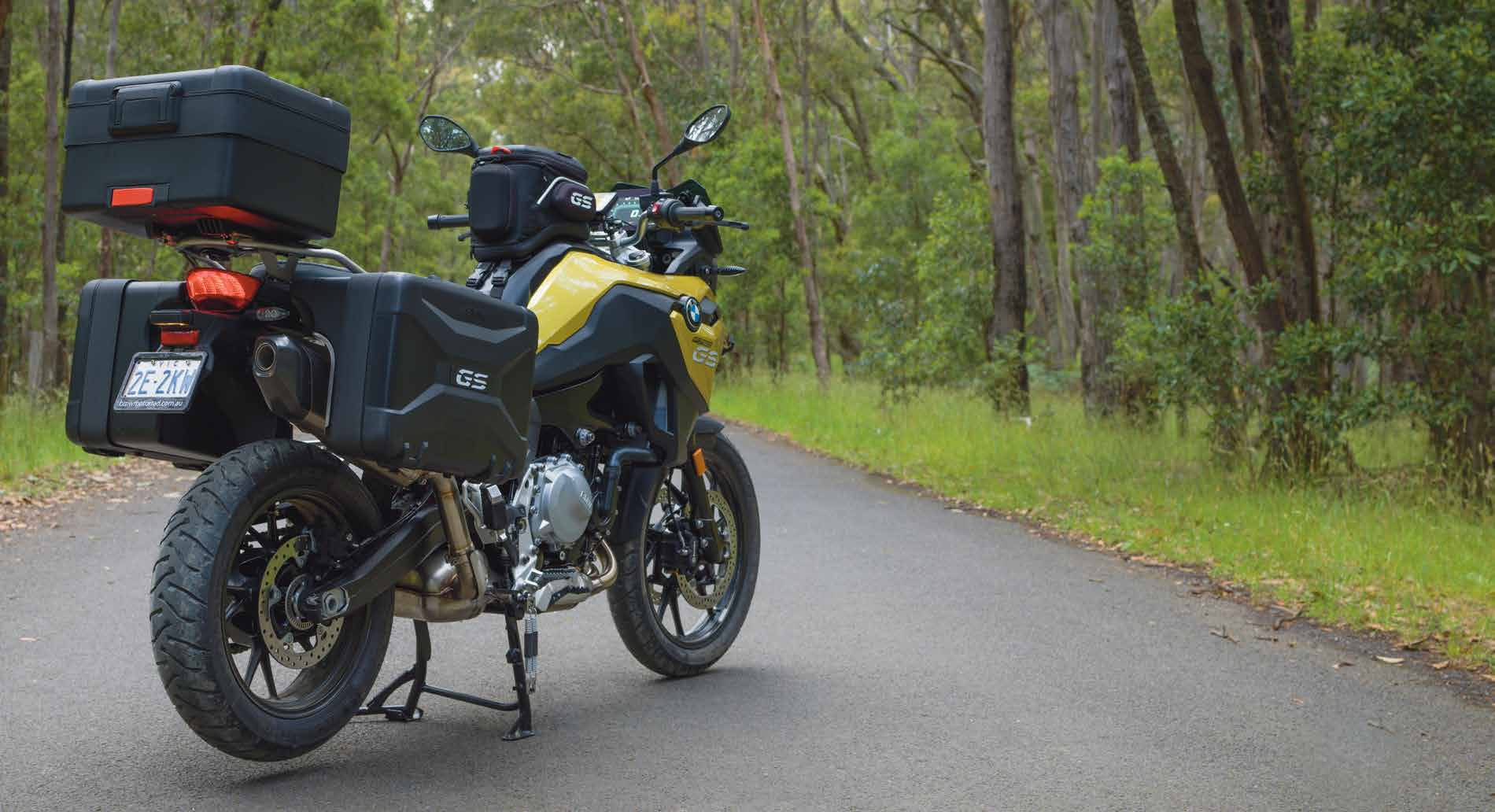 There’s a huge catalogue of accessories available for the F750GS as well, including some excellent luggage options.
There’s a huge catalogue of accessories available for the F750GS as well, including some excellent luggage options.
 The Akro is the go! It’s worth the extra expense to feel that 270-degree timing throb.
The Akro is the go! It’s worth the extra expense to feel that 270-degree timing throb.

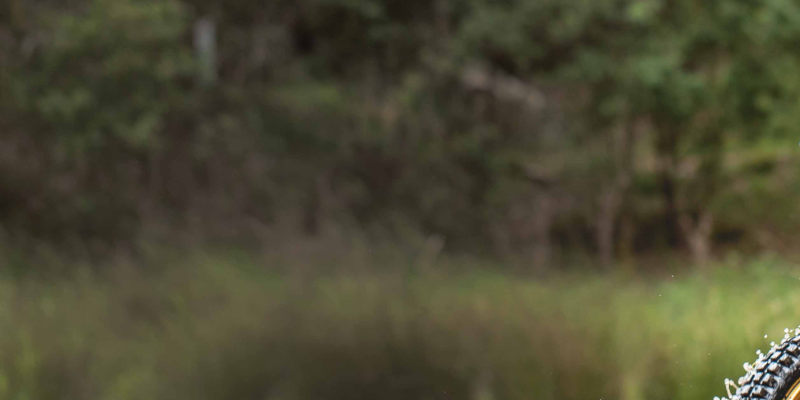

















Comments